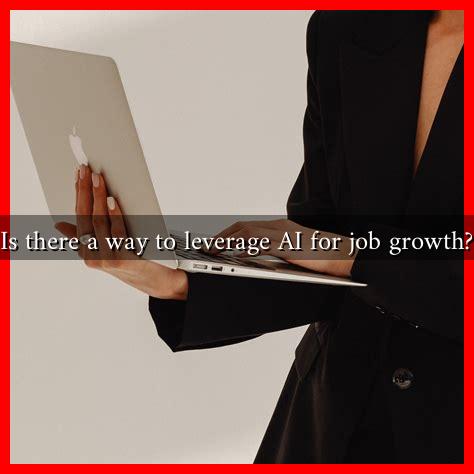-
Table of Contents
Is There a Way to Leverage AI for Job Growth?
As artificial intelligence (AI) continues to evolve, its impact on the job market has become a topic of intense debate. While some fear that AI will lead to job displacement, others argue that it can be a powerful tool for job growth. This article explores how AI can be leveraged to create new job opportunities, enhance existing roles, and drive economic growth.
The Dual Nature of AI: Threat or Opportunity?
AI’s influence on employment is often viewed through a dual lens. On one hand, automation and machine learning can replace repetitive tasks, leading to job losses in certain sectors. On the other hand, AI can also create new roles and enhance productivity, leading to job growth. According to a report by the World Economic Forum, it is estimated that AI will create 97 million new jobs by 2025, while displacing 85 million jobs. This statistic highlights the potential for AI to be a net positive force in the job market.
How AI Can Drive Job Growth
There are several ways in which AI can be leveraged to foster job growth:
- Creation of New Job Categories: As AI technologies advance, entirely new job categories are emerging. Roles such as AI ethicists, data scientists, and machine learning engineers are in high demand. These positions require specialized skills that are not easily automated.
- Enhancing Existing Roles: AI can augment human capabilities, allowing workers to focus on more complex and creative tasks. For example, in healthcare, AI can assist doctors in diagnosing diseases, enabling them to spend more time on patient care.
- Boosting Productivity: AI can streamline operations and improve efficiency across various industries. For instance, in manufacturing, AI-driven robots can handle repetitive tasks, allowing human workers to engage in higher-value activities.
- Supporting Small Businesses: AI tools can provide small businesses with access to advanced analytics and marketing strategies that were previously only available to larger corporations. This democratization of technology can lead to job creation in local economies.
Case Studies: Successful AI Integration
Several companies have successfully integrated AI into their operations, leading to job growth:
- Amazon: The e-commerce giant has invested heavily in AI to optimize its supply chain and improve customer service. While automation has replaced some warehouse jobs, Amazon has also created thousands of new positions in tech and logistics.
- IBM: IBM’s Watson has been used in various sectors, including healthcare and finance. By automating data analysis, Watson allows professionals to focus on strategic decision-making, leading to job creation in advisory roles.
- Salesforce: The CRM platform has integrated AI to enhance customer relationship management. This has led to the creation of new roles in data analysis and customer experience management.
Challenges and Considerations
While the potential for job growth through AI is significant, there are challenges that must be addressed:
- Skill Gaps: As new technologies emerge, there is a growing need for workers to acquire new skills. Upskilling and reskilling initiatives are essential to prepare the workforce for AI-related jobs.
- Ethical Concerns: The deployment of AI raises ethical questions regarding bias, privacy, and job displacement. Companies must navigate these issues responsibly to ensure equitable job growth.
- Economic Disparities: The benefits of AI may not be evenly distributed across all sectors or regions. Policymakers must work to ensure that AI-driven growth is inclusive and accessible to all.
Conclusion: Embracing AI for a Brighter Future
In conclusion, while AI presents challenges, it also offers significant opportunities for job growth. By creating new roles, enhancing existing jobs, and boosting productivity, AI can be a catalyst for economic development. However, to fully leverage these benefits, it is crucial to invest in education and training, address ethical concerns, and ensure that the advantages of AI are shared broadly. As we move forward, embracing AI as a partner in the workforce will be essential for fostering a thriving job market.
For more insights on the impact of AI on the job market, you can visit World Economic Forum’s Future of Jobs Report.

